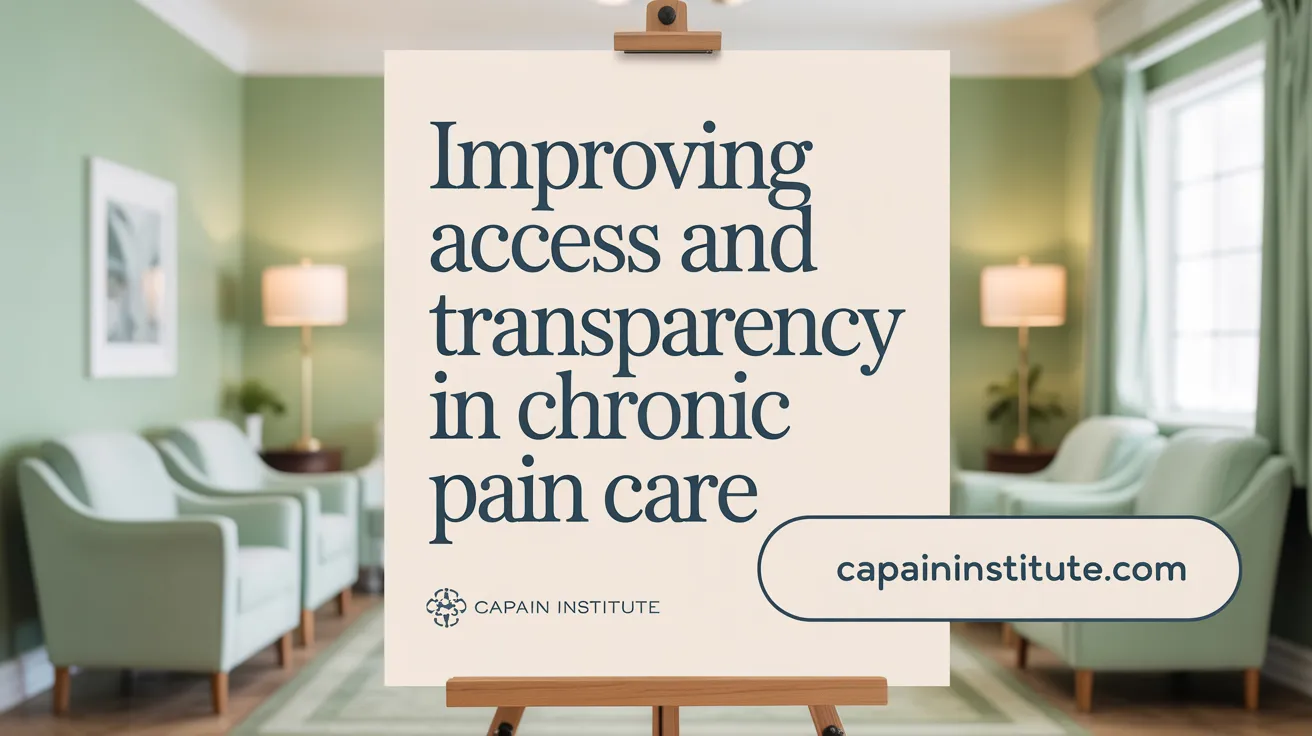The Growing Importance of Payment Plans in Pain Management
As chronic pain affects millions and treatment costs climb, medical payment plans are becoming essential tools for patients and providers. Understanding the complexities of pain management billing, insurance coverage, and financing options can empower patients to access necessary care without overwhelming financial strain. This article explores the landscape of payment plans tailored for pain management, insurance intricacies including Medicare, and best practices that ensure smooth financial navigation for both patients and healthcare providers.
Medical Billing and Insurance Coverage in Pain Management

What pain management services are typically covered and how is billing handled?
Pain management includes a wide range of services such as comprehensive pain assessment, medication management, interventional procedures, psychological therapies, alternative treatments, and rehabilitation. Billing for these services involves the use of CPT and ICD-10 codes, accurate and thorough documentation, and the correct application of billing modifiers.
Medicare Part B covers many pain management services including acupuncture for chronic low back pain, chiropractic services, physical and occupational therapy, and behavioral health services. Patients usually pay 20% of the Medicare-approved amount after meeting deductibles, with costs varying based on provider assignment acceptance and care setting.
Recently, CMS introduced new bundled payment codes (G3002 and G3003) for chronic pain management services. These codes cover initial face-to-face visits for at least 30 minutes involving diagnosis, assessment, treatment planning, medication management, and care coordination, with add-on codes applicable for extended time spent.
What are common billing challenges in pain management?
Pain management billing often faces hurdles such as securing prior authorization before procedures, managing limitations on procedure frequency, coding complexity due to multimodal treatment approaches, and post-service claim reviews.
Denials commonly arise from missing prior authorizations, use of incorrect or missing modifiers, insufficient documentation to prove medical necessity, and mistakes in code bundling or diagnosis assignment. Additionally, reimbursement for non-pharmacologic therapies, such as psychological or alternative treatments, can be challenging.
To mitigate these challenges, providers must stay informed about payer-specific rules and frequently update coding knowledge. Effective denial management includes analyzing denial reasons, resubmitting with supporting documentation, and appealing within deadlines to optimize revenue and cash flow.
Medicare Coverage and Costs for Pain Management Services

What pain management services does Medicare cover and what costs do patients face?
Medicare provides comprehensive coverage for various pain management services covered by Medicare through its different parts. Medicare Part B covers outpatient services including acupuncture for chronic low back pain under Medicare (limited to 12 visits within 90 days), chiropractic services for spinal subluxation, physical and occupational therapy, behavioral health treatments, and chronic pain management visits. Typically, beneficiaries pay 20% coinsurance after satisfying the Part B deductible.
Medicare Part D covers prescription medications related to pain management, such as opioids and antidepressants, with coverage depending on the specific plan.
Medicare Advantage (Part C) plans, administered by private insurers, often enhance coverage by offering additional pain management services beyond those provided by Original Medicare.
Costs to patients vary based on several factors including the provider’s charge, service location, whether the provider accepts Medicare assignment, and any applicable facility fees, especially in hospital outpatient settings where copayments or coinsurance can increase costs.
Medigap (Medicare Supplement) plans help reduce out-of-pocket expenses such as deductibles, coinsurance, and copayments, providing financial relief for covered services.
Effective communication between patients and providers about expected costs and coverage details is essential to avoid unexpected charges and to understand which services Medicare will cover. Patients are encouraged to discuss treatment plans and related expenses proactively with their healthcare professionals. For more on these nuances, see Medicare pain management coverage, Medicare pain management costs 2025, and Pain management cost without insurance.
Patient Payment Plans and Medical Financing: Making Pain Management Affordable

Why are payment plans important for pain management patients and how do they work?
With the rise of high-deductible health plans and growing out-of-pocket costs, many patients find it difficult to afford pain management treatments upfront. Payment plans offer a practical solution by allowing patients to break down large medical bills into smaller, manageable payments over time. These plans can be structured either as installment plans, which are paid off fully over an agreed period, or recurring plans with ongoing payments for continued care.
Self-service digital platforms enable patients to set up and manage their own plans online, providing greater transparency and control. Automation of payment processing—such as securely saving card information and pre-authorizing payments—helps reduce administrative workload for providers and lowers bad debt by promoting timely payments. Clear communication about plan options and proactive notifications further improve patient understanding and adherence.
What medical financing options exist beyond traditional payment plans?
Beyond standard payment plans, patients can access medical financing through loans and medical credit cards specifically designed for healthcare expenses. These financial products often provide interest-free promotional periods or low, fixed interest rates, but approval depends on the patient’s creditworthiness.
Financing is particularly useful for covering elective procedures or treatments not fully covered by insurance, such as certain chronic pain therapies. Providers sometimes collaborate with third-party finance companies to facilitate quick loan approvals and reduce administrative burdens. Patients, however, should carefully review the terms, including any deferred interest policies and the potential effects on their credit scores before committing.
How do providers set plan parameters and communicate options?
Providers typically establish payment plan parameters such as maximum duration, payment frequency, and minimum monthly amounts to balance patient flexibility with financial control. Explaining these details through staff and digital channels helps patients choose plans aligned with their financial situation.
Effective communication combined with reporting tools enables providers to track payment plan performance, identify issues early, and optimize their collections processes while maintaining strong patient relationships.
This combination of flexible payment solutions and financing options makes pain management more accessible and financially manageable for patients navigating costly treatments.
Best Practices for Providers Offering Payment Plans and Billing Services

What best practices should providers follow when offering payment plans for pain management?
Providers should start by verifying insurance benefits to understand coverage limits and patient costs. Clear communication with patients about their financial responsibility, including deductibles, coinsurance, and non-covered treatments, is essential for building trust and avoiding surprises.
Accurate and up-to-date medical billing documentation is critical. This includes precise use of CPT and ICD-10 codes, proper modifiers, and clear documentation demonstrating medical necessity to reduce claim denials and delays.
When establishing payment plans, providers should define clear parameters such as the maximum duration and payment frequency. Offering flexible options helps patients manage their out-of-pocket expenses while providers maintain control over cash flow. Adopting best practices for patient payment plans and utilizing self-service payment plans and automations can greatly improve this process.
Training billing and administrative staff on available payment options and regulatory compliance is important. Leveraging digital tools for self-service payment plan setup and automated billing can improve efficiency and enhance patient experience.
Finally, providers should regularly monitor payment plan performance with reporting tools. This tracking helps identify late payments or inefficiencies, allowing timely interventions and optimized collections.
Adopting these best practices supports improved revenue cycle management and patient satisfaction in pain management care.
Enhancing Patient Access and Financial Transparency in Chronic Pain Treatment

How can providers improve patient access and transparency regarding pain management costs?
Interdisciplinary pain management, which combines medical, psychological, and physical therapies, is proven effective but frequently faces insurance coverage gaps in pain treatment. To bridge this divide, providers should prioritize clear communication about costs and offer financial counseling to patients before treatment begins.
Flexible financial options greatly enhance accessibility. Membership programs, like tiered point-based plans, and flexible self-pay or installment payment plans allow patients to spread out expenses, making care more affordable. Self-service tools enable patients to manage their payment plans, improving transparency and autonomy.
Knowledge of support resources is vital. Providers should inform patients about Medicare Savings Programs, charity care, and other government assistance to lessen out-of-pocket burdens. These programs can supplement insurance and reduce financial stress, encouraging patients to pursue necessary care.
Moreover, efficient billing practices are essential. Accurate coding, timely claim submissions, and effective denial management not only optimize provider revenue but reduce patient payment surprises. Clear, honest conversations about insurance coverage and costs foster trust, decrease anxiety, and support adherence to chronic pain treatment plans. This comprehensive approach benefits both patient outcomes and practice sustainability.
Empowering Patients and Providers Through Informed Payment Options
Understanding the complex interplay of insurance coverage, medical billing, and payment plan options is essential for both patients and providers in pain management. As chronic pain care often involves multifaceted treatments and enduring financial commitments, structured payment plans and medical financing play pivotal roles in easing financial burdens. Medicare coverage offers foundational support, yet patients must navigate coinsurances and service limitations. Providers benefit from adopting best billing practices and transparent communication, which improve collection efficiency and patient trust. Ultimately, informed payment strategies foster better access to necessary pain management treatments, supporting improved patient outcomes and sustainable healthcare delivery.
